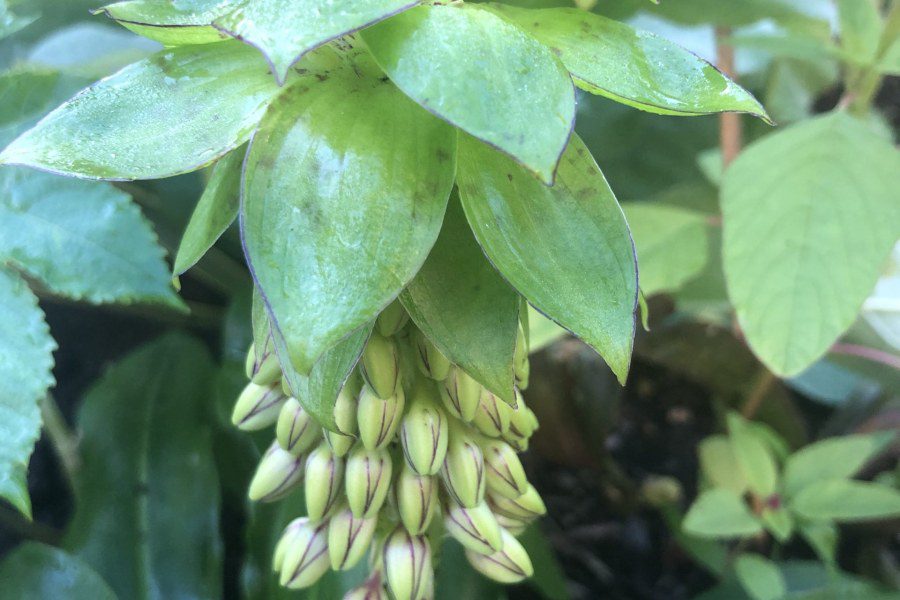Yes, Eucomis bicolour, commonly known as the pineapple lily, typically comes back every year. This plant is a perennial, meaning it can live for more than two years and will regrow each season from its underground bulb.
Is Eucomis hardy in the UK?
However, its ability to come back annually can depend on the climate and growing conditions:
- In warmer climates (USDA zones 7-10): Eucomis bicolor can be left in the ground year-round, and it will naturally re-emerge each spring.
- In colder climates: The bulbs need to be dug up and stored indoors during the winter to protect them from hard frost. They can then be replanted in the spring after the danger of frost has passed. In the UK the bulbs can withstand a mild winter in the ground if mulched
Proper care, including well-drained soil, adequate sunlight, and appropriate watering, can help ensure the plant’s health and its ability to return each year.
Eucomis bicolor, commonly known as the pineapple lily, is a striking ornamental plant native to South Africa. Here are some detailed characteristics and care instructions for this unique plant:
Description
- Appearance: The pineapple lily gets its name from its pineapple-like flower spikes. The plant produces rosettes of strap-shaped leaves, which are usually green with a hint of purple at the base.
- Flowers: The flowers are small, star-shaped, and usually light green with a purple edge, clustered on a tall spike that can reach up to 1-2 feet (30-60 cm) in height. Above the flowers, a tuft of green bracts resembles a pineapple top.
- Bloom Time: Eucomis bicolor typically blooms in late summer to early fall, providing an extended display of unusual and attractive flowers.
Growing Conditions
- Hardiness: It is hardy in USDA zones 7-10. In regions colder than zone 7, the bulbs should be lifted and stored indoors over winter.
- Soil: The plant prefers well-drained soil. Sandy or loamy soils are ideal. It’s crucial to avoid waterlogged conditions, as the bulbs are susceptible to rot.
- Sunlight: Eucomis bicolor thrives in full sun to partial shade. In areas with very hot summers, some afternoon shade can help prevent the leaves from scorching.
- Watering: Water regularly during the growing season, ensuring the soil is moist but not waterlogged. Reduce watering as the plant goes dormant in the winter.
- Fertilizing: Feed with a balanced, slow-release fertilizer in spring as new growth begins. Avoid over-fertilizing, as this can lead to excessive foliage at the expense of flowers.
Planting and Care
- Planting Depth: Plant the bulbs about 4-6 inches (10-15 cm) deep and space them about 6-12 inches (15-30 cm) apart.
- Mulching: In colder regions, mulch heavily in the fall to protect the bulbs from freezing temperatures if you choose to leave them in the ground.
- Winter Care: In USDA zones 7 and below, dig up the bulbs before the first frost. Allow them to dry, then store them in a cool, dry place until spring.
- Pests and Diseases: Eucomis bicolor is generally pest-free but can occasionally suffer from slugs and snails. Watch for signs of rot, particularly in overly wet conditions.
Propagation
- Division: The easiest way to propagate Eucomis bicolor is by dividing the bulbs in the spring. Each section should have at least one growing point.
- Seed: While possible, growing from seed is a slower process and can take several years for the plants to mature and flower.
Landscape Uses
- Borders and Beds: Its unique appearance makes it a great addition to mixed borders and flower beds.
- Containers: Eucomis bicolor also performs well in containers, which is especially useful for overwintering in colder climates.
- Cut Flowers: The long-lasting flowers make excellent cut flowers for arrangements.
By following these guidelines, you can enjoy the exotic beauty of Eucomis bicolor in your garden year after year.


